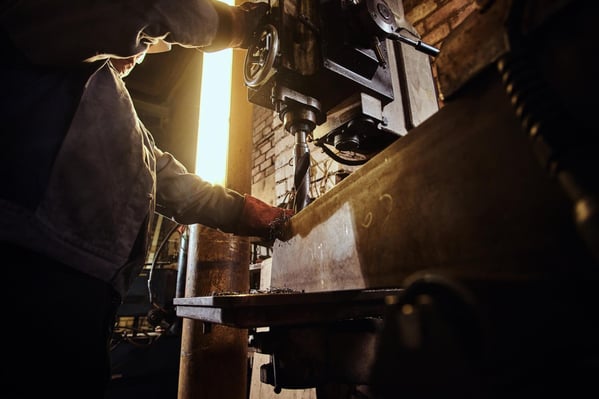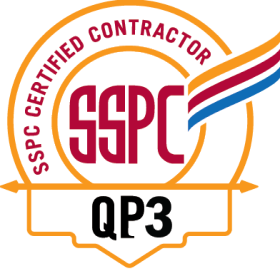This is the process of constructing large industrial applications out of steel, such as tanks, reservoirs, and smokestacks.
Building structures like these require a huge amount of powerful equipment, teams of skilled craftsmen, and many decades of experience to manage the weight of logistics effectively.
If you’re new to the world of heavy fabrication, continue reading to learn more about this exciting field.
Heavy Metal Fabrication: an Overview

Heavy fabrication is a complex discipline that requires the careful coordination of many teams to machine, mold, assemble, coat, and deliver large steel applications. These heavy fabrications include pressure vessels, penstock, casing, standpipes, reservoirs, and a huge variety of shop-built tanks.
Because applications like these are used in nearly every market, you’ll find heavy fabricators working within most industries, including oil refining, transportation, manufacturing, air and seaports, military facilities, and food production, to name a few.
What is Involved in this process?

The heavy steel fabrication process usually involves a combination of the following steps:
Cutting
All heavy metal fab projects use saws, waterjets, lasers, and other cutting machines to cut steel sheets to the required size.Drilling & Punching
These techniques allow steel sections to be bolted together, which is performed using high-pressure punching tools or high-speed twist bits.Bending & Rolling
Cylindrical tanks, casing, piling, and other applications use heavy metal. This shape is achieved using high-powered rollers, press brakes, and other tools.Welding
Shop-built tanks are assembled in the shop, while field-erected tanks are welded together on the job site.Surface Prep & Coatings
A series of industrial coatings is usually necessary to help an application withstand the test of time. These coatings protect the steel from corrosion and help maintain drinking water quality in AWWA D100 tanks and reservoirs.Here at T BAILEY LLC, we also perform site preparation as part of our metal fabrication process.
Tools Used By Heavy Metal Fabrication Companies

Building large steel tanks, penstock, and pile cap frames requires specialized heavy metal machinery. To give you an idea of what it takes to fabricate projects of this scale, here are some of the tools used at our metal fab facility:
- Large rollers capable of forming 2.75” x 10’ wide steel plate
- Multiple 20-ton overhead bridge cranes
- 11’ x 50’ water table cutters
- RT hydraulic cranes capable of lifting 60-tons
- A fleet of forklifts with a 55-ton capacity
- CNC plasma cutting machines
We also use advanced heavy welding equipment to ensure high-grade welds. All our welders and procedures are qualified according to code, and routine inspections, including x-ray examinations, are performed to verify weld quality.
Light Metal Fabrication vs Heavy Metal Fabrications
At this point, you’re likely wondering, what’s the difference between light and heavy fabrications? Here are two ways you can tell the difference:
1. The Scale of Fabrication
What is being created? Heavy fabrication involves building large tanks, steel casing, dolphin caps, industrial steel stacks, and other large-scale projects.
On the other hand, light manufacturing creates smaller products like household products, medical equipment, restaurant equipment, and small farming applications.
2. The Size of the Fabrication Facilities
Another difference between the heavy and light industries is the scale of the facilities that produce the products.
Light industry is small-scale and can sometimes be performed in a space as small as someone’s garage, whereas heavy metal fabrications require massive amounts of space. Machine shops cut metal using laser cutting and heat treatment manufacturing processes.
T BAILEY LLC, for example, sits on 30 acres of covered facilities and outdoor workspaces, including a 104,000 sq ft fabrication shop and 16,000 sq ft industrial painting facility.
Best Materials for Heavy Metal Fabrication
While aluminum, brass, bronze, and even copper are great materials for light metal fabrication, heavy fabrications require more robust materials.
Heavy fabrication projects require metal that won’t crack, bend, or be compromised by extreme weather changes. This is why we use carbon steel and, occasionally, stainless steel. Steel tanks are impervious to the elements and can stand for over 100 years when properly coated, welded, and maintained.
Industry-Leading Sheet Metal Fabrication Shops Near You
Since 1991, T BAILEY LLC has been serving the Northwest with high-quality metal fabrication. Our expert crews have decades of experience assembling steel fabrication projects of immense proportions, including multi-million-gallon water reservoirs, complex penstock bi/trifurcations, and turn-key tank farms in remote locations like Alaska. From heavy fabrication services, other light fabrications to massive metal structures across many industries - T BAILEY are the trusted metal fabricators.
Please visit our steel fabrication page or contact us today to learn more about our expansive heavy metal fabrication capabilities. We are your experienced fabricators.






